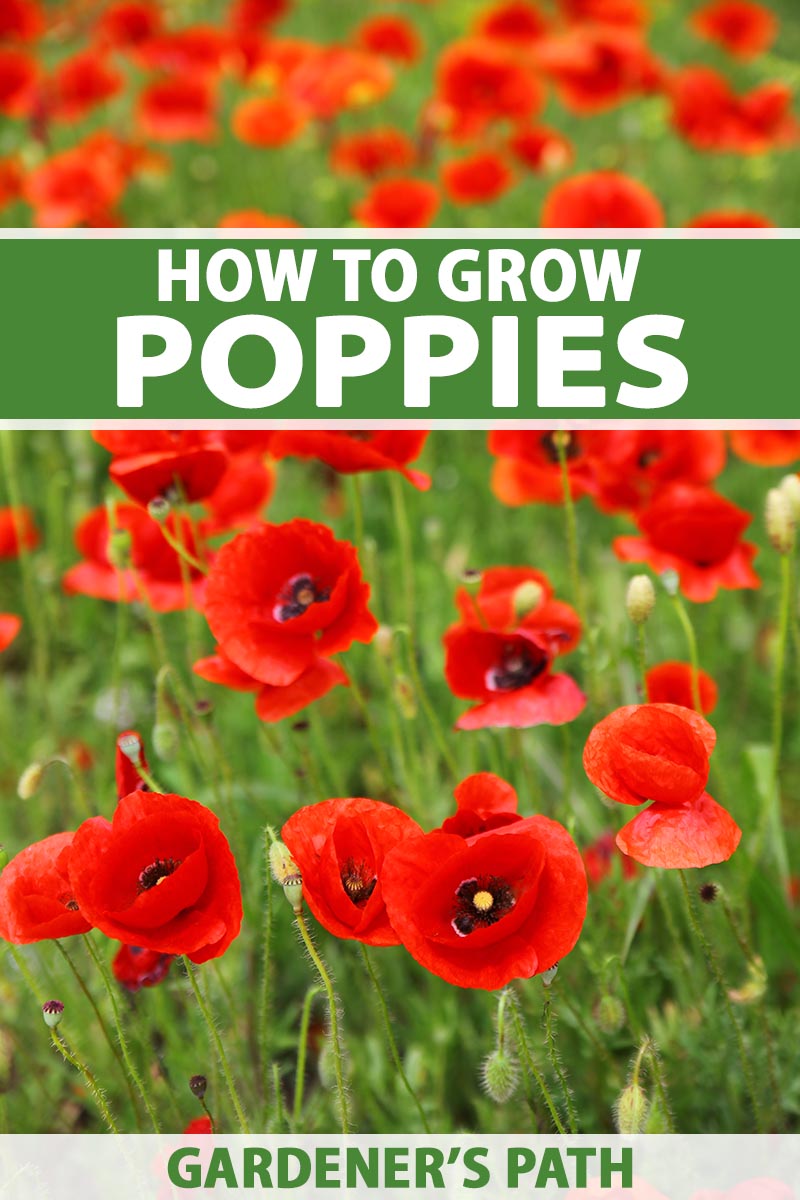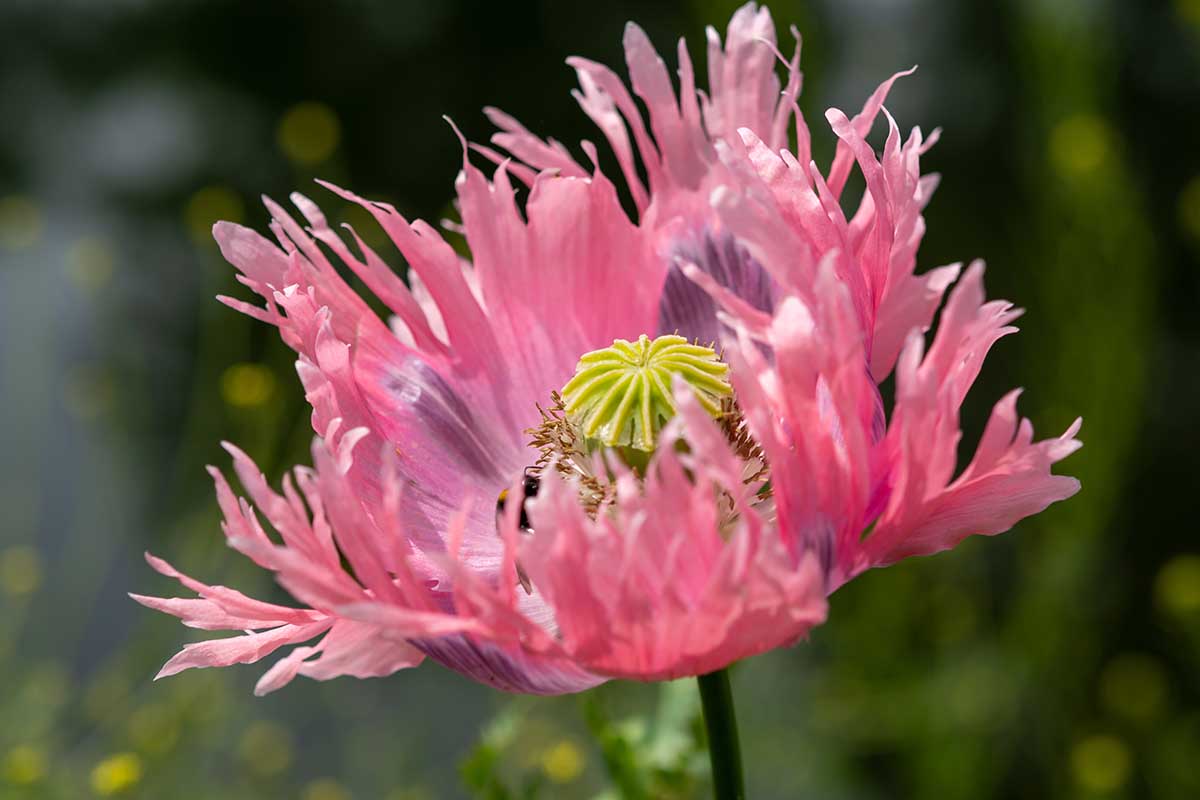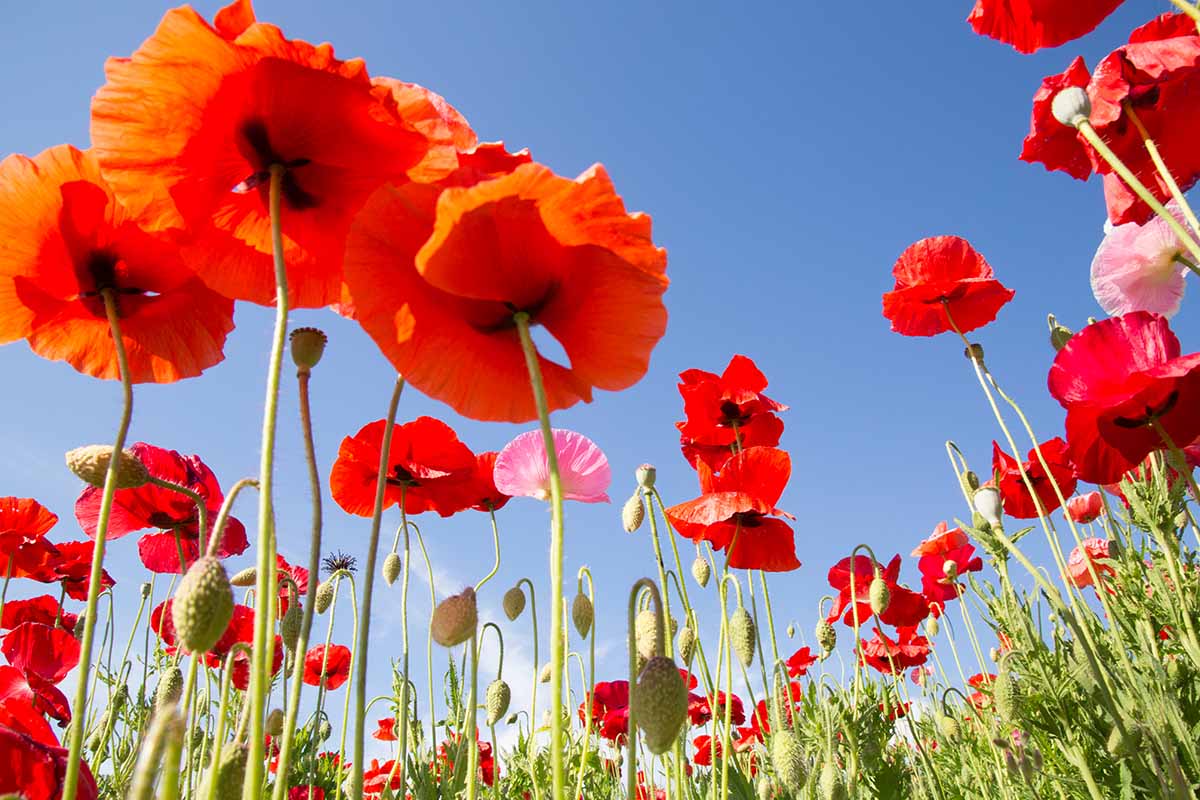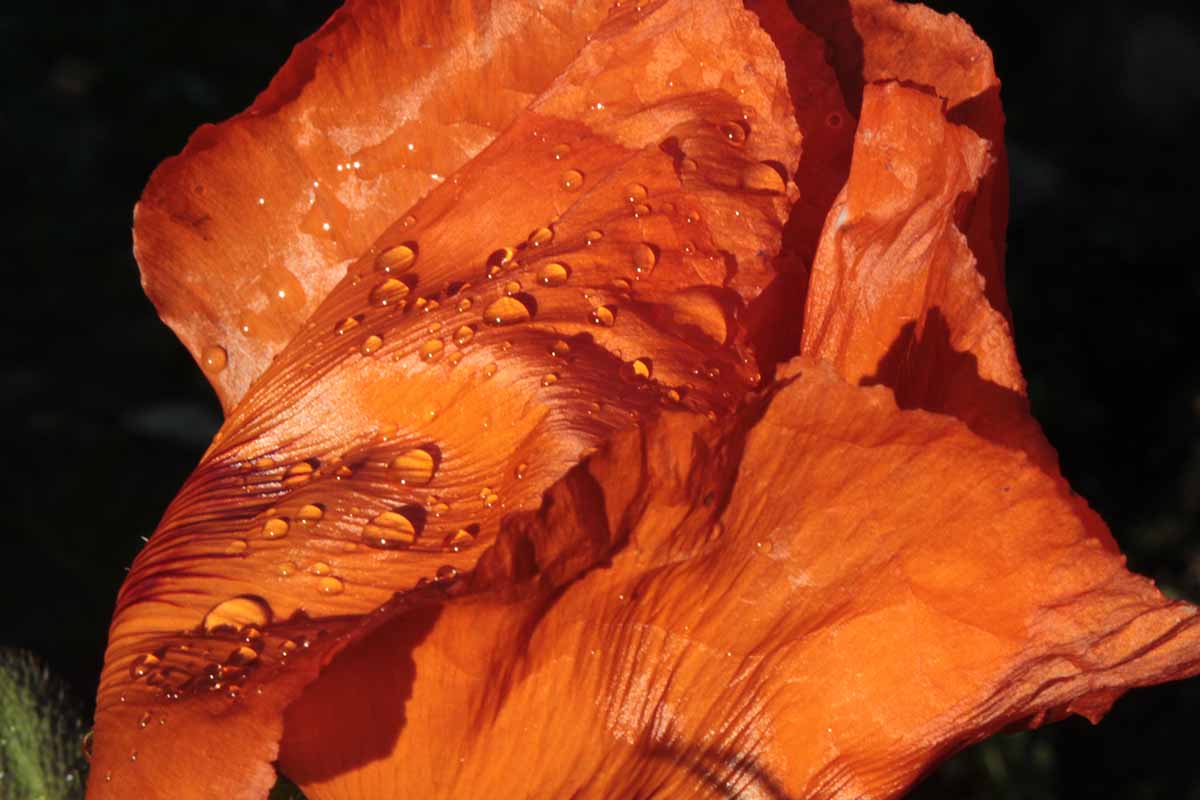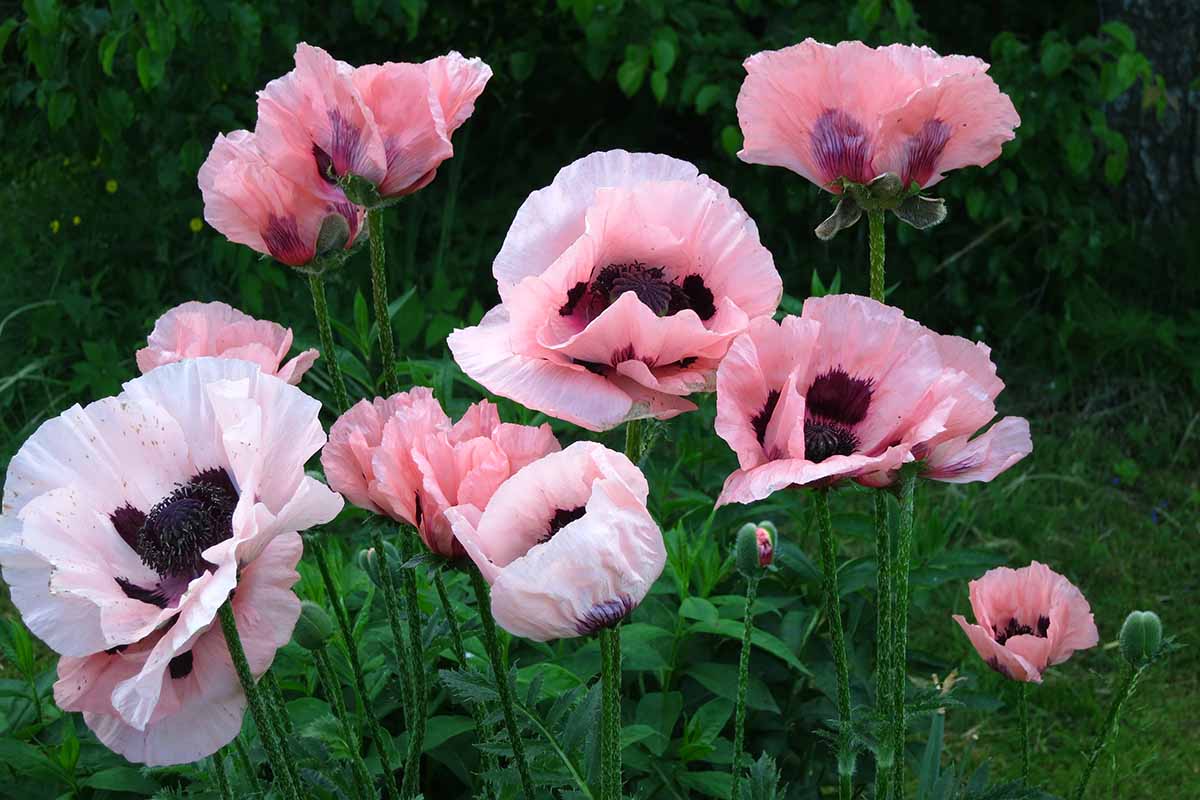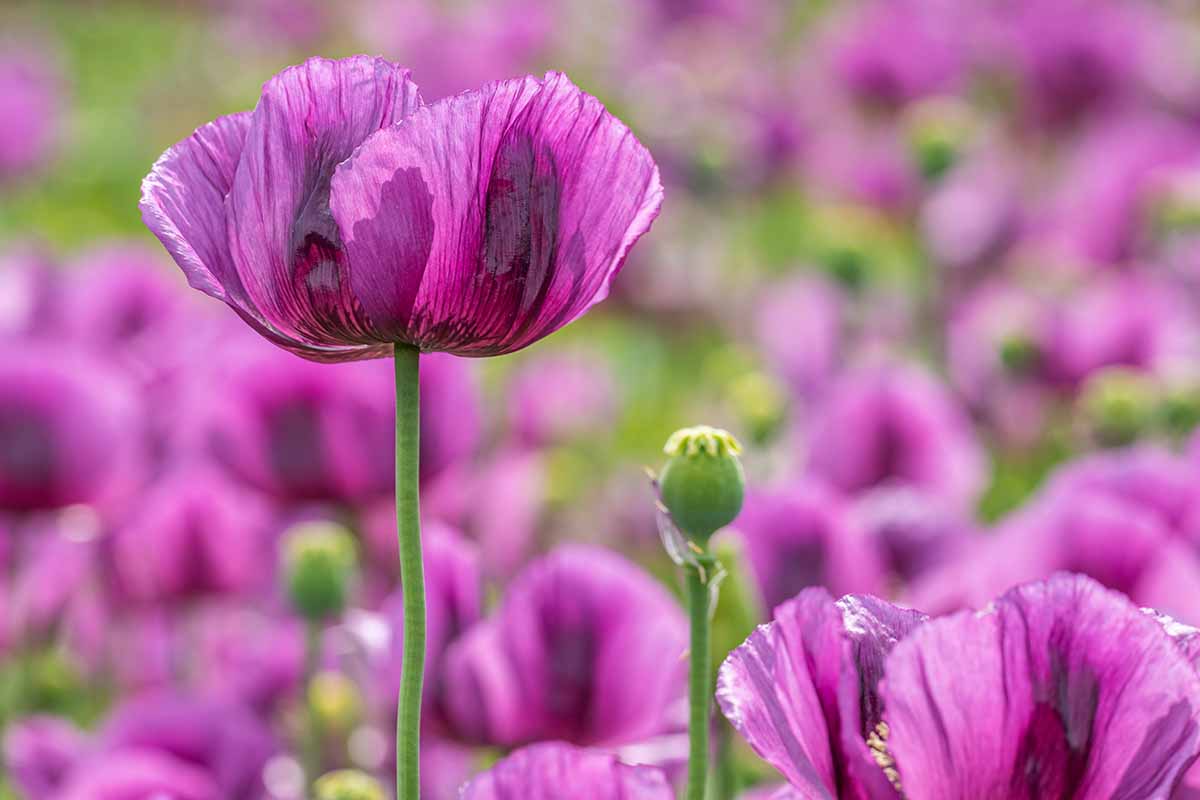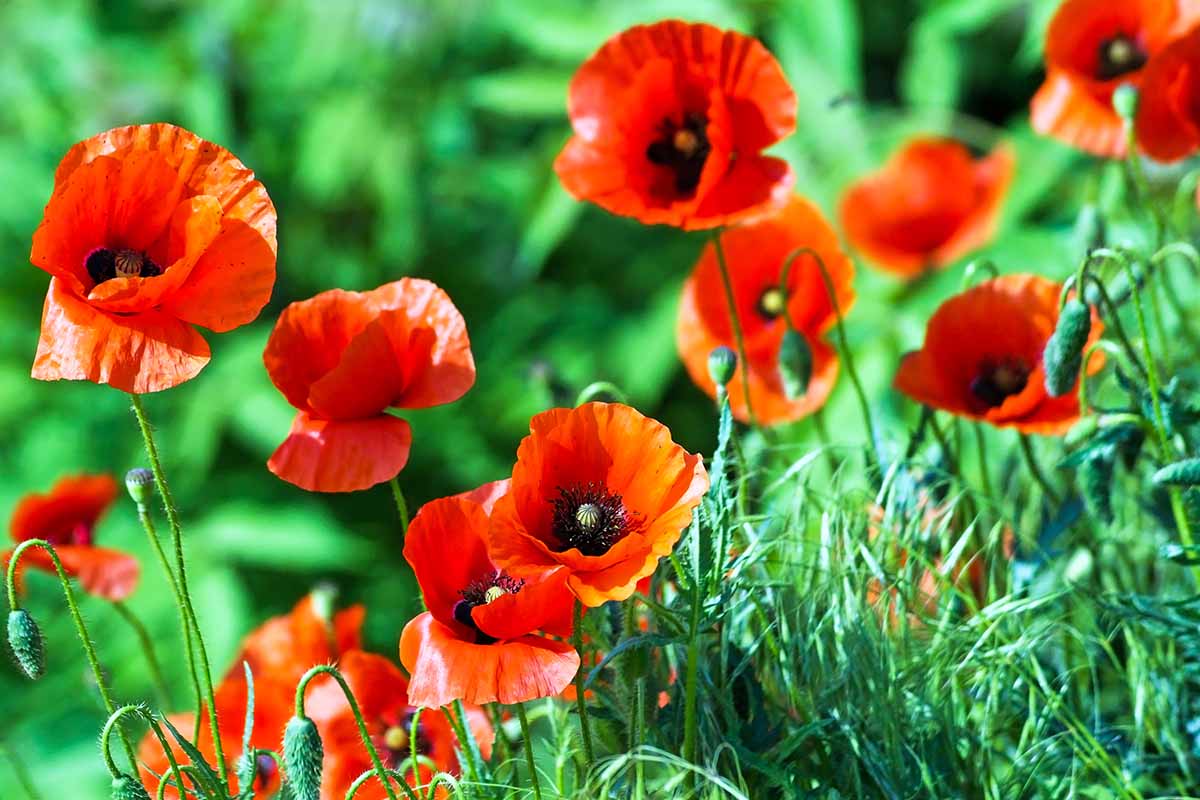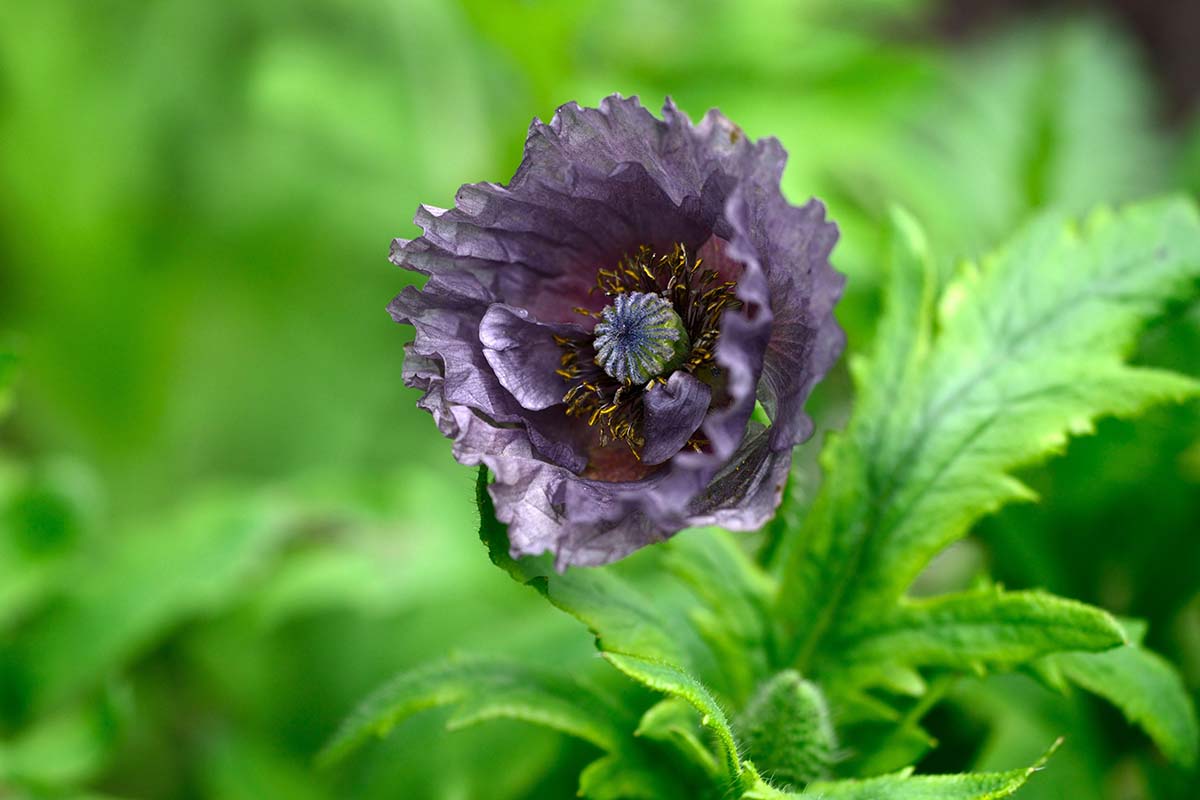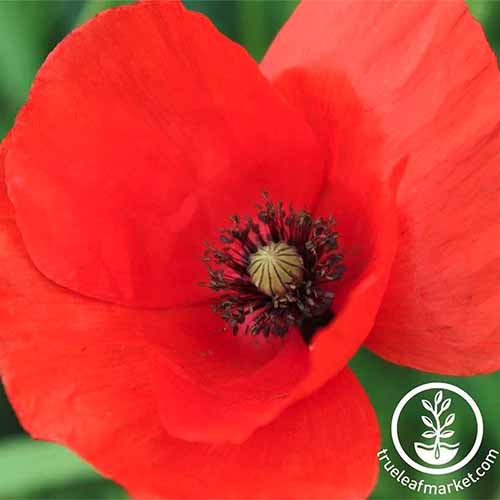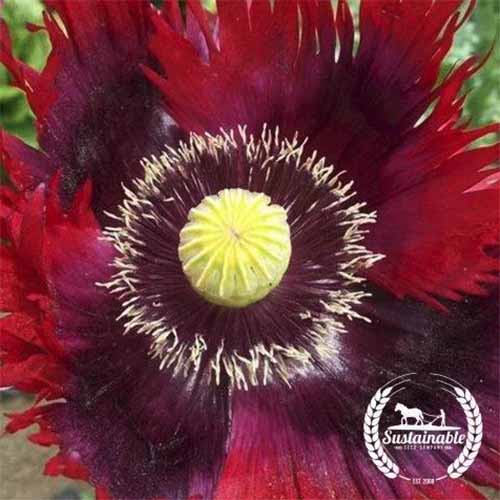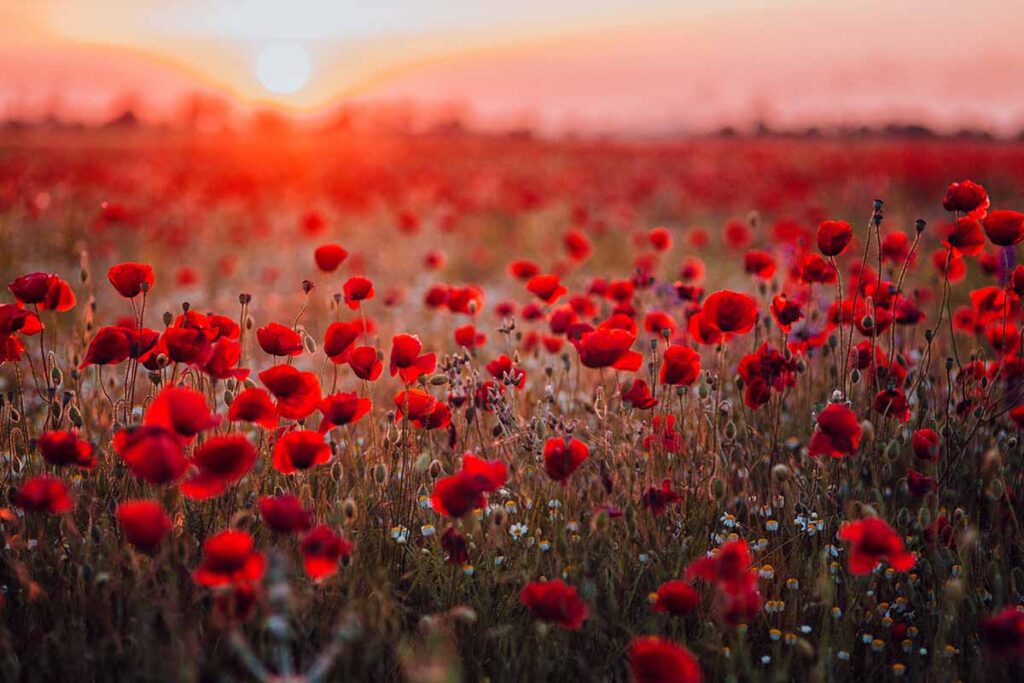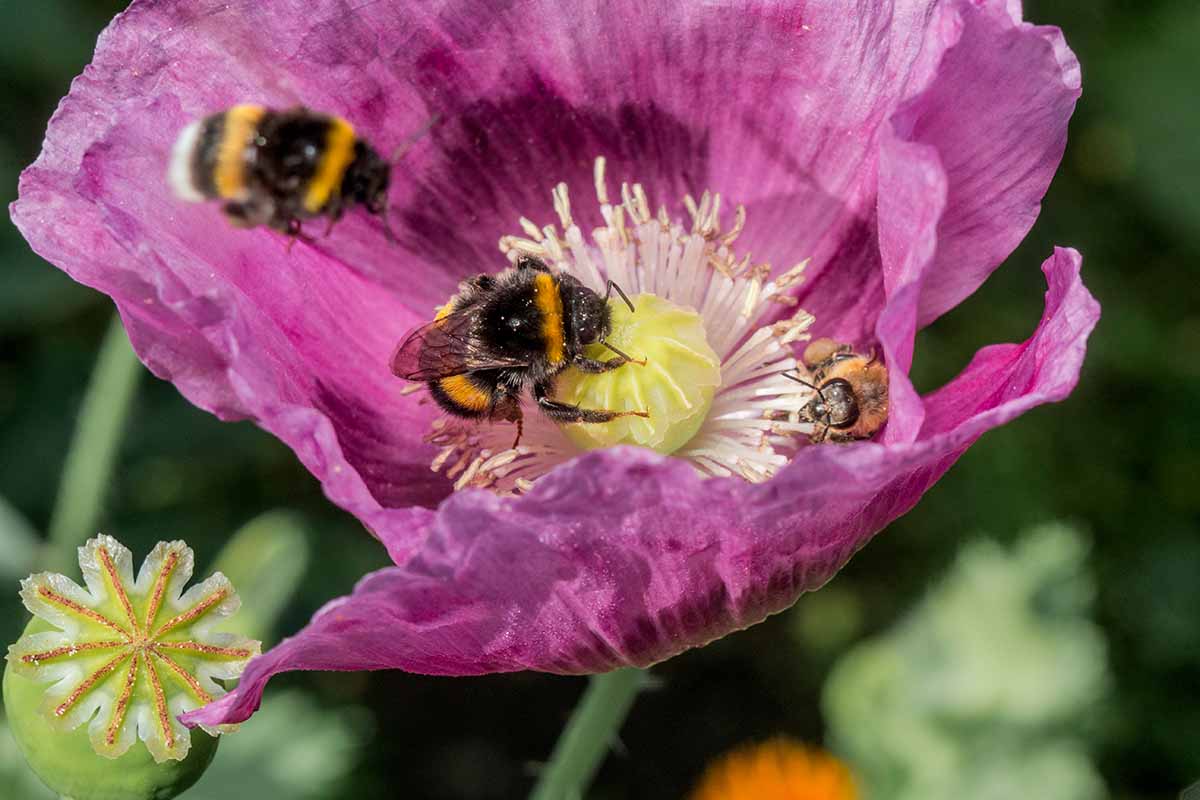The paper-thin petals are incredibly elegant, in shades that range from eye-poppingly vibrant to soft and subtle. The blooms can be petite and simple or massive and full. There are species that do well in the heat, and those that thrive in cold weather. Some stay short and others tower above the rest of the flowers in the garden. They can be annuals or perennials, and they self-seed freely. We link to vendors to help you find relevant products. If you buy from one of our links, we may earn a commission. They’re pretty sensational, and I can’t imagine my garden without them. Whether this is your first go at growing poppies or you’re just looking for more information on making them thrive, this guide has your back. Here’s what to expect: Ready to fall (even more) in love with this classic flower? Here we go.
Cultivation and History
Poppies are plants in the Papaver genus and they have been with us for a long, long time. They’ve been discovered in Egyptian tombs and described in Greek mythology. Poppies can be annuals, biennials, or perennials, but they’re most often grown as annuals. They grow in USDA Hardiness Zones 3 to 10, depending on the species and cultivar. When we talk about poppies, we’re often referring to breadseed (also known as opium) poppies, P. somniferum. Breadseed poppies, as the name suggests, are the kind used in the culinary world for their seeds. But keep in mind that the entire plant is toxic, except for the seeds. The law is ambiguous, and only when it can be shown that you’re growing them to harvest the opium might you face legal consequences. You must have the knowledge that a poppy seed pod can be used to create opium to be on dangerous legal ground. That’s because the poppies that we grow for their beautiful flowers and seed pods are the same species grown for opium. The gardens at Thomas Jefferson’s Monticello were ordered cleared of poppies by the Drug Enforcement Agency, as have been other private gardens across the US. But most home gardeners are probably safe. So long as you’re only growing the plants for their ornamental value, there’s nothing to worry about. The peony-flowered poppy (P. paeoniflorum) is another commonly grown species with full, peony-like flowers. Iceland poppies (P. nudicaule), Welsh poppies (P. cambricum), Oriental poppies (P. orientale), and Flanders (and the strain known as Shirley) poppies (P. rhoeas) are also popular species. Bright red Flanders poppies can often be seen growing on the sides of freeways and in cultivated “wildflower” fields. Alpine types (P. alpinum) are showy, though lesser-known than their cousins. Spanish poppies (P. rupifragum) are hard to find, but good for growing in hot areas. The Himalayan (Meconopsis betonicifolia), celandine (Stylophorum diphyllum), prickly (Argemone mexicana), Mexican tulip (Hunnemannia fumariifolia), and California poppy (Eschscholzia californica) are also part of the same family. For reference, the following are annuals:
BreadseedCaliforniaFlandersPeonyPrickly
And these species are perennials:
Alpine (short-lived)CelandineHimalayanIcelandic (short-lived)Mexican tulipOrientalSpanishWelsh
The flowers can be single or double, and the petals can be smooth-edged or ruffled. Shirley poppies and P. orientale varieties bloom in the spring, while breadseed and California poppies bloom in the summer. Each individual blossom lasts just a few days or so, but the plants constantly send up new buds, so you can count on a fairly long-lasting display. Beyond the blossoms, the seed pods can be extremely beautiful as well. And the leaves are thin, almost like tissue paper that has been balled up and smoothed back out. Plants can range from low-growing and under a foot tall to up to three feet tall for some breadseed cultivars. Plants will freely self-seed if you allow the seed pods to mature and drop. Plants from the same species will cross-pollinate, but that just means you’ll end up with something different but surely just as interesting next year.
Propagation
The easiest way to get started is by propagating seed. This isn’t a plant that you can start indoors, though. The seeds need a nice, long period outside with a cycle of freezing and thawing to germinate, and they don’t like being transplanted. Just start them outside wherever you want them to grow. You can also grab bare root plants and transplants from nurseries, particularly of the P. orientale and California species.
From Seed
Seeds should be sown in the fall or winter. If you sow during the spring, the plants might not flower until the following year, if they germinate at all. Iceland poppies can be safely planted in the spring. Plants prefer loamy, rich, well-draining soil. Prepare the soil in an area with full sun by adding lots of well-rotted compost to loosen clay, or add water retention to sandy soil. Sprinkle the seeds on top of the prepared soil and then press them into the soil using the dry palm of your hand. You don’t want to bury the seeds more than an eighth of an inch because they need light to germinate. If you want to avoid over-seeding, mix the seeds with a good amount of sand before sowing. Mist the soil rather than watering it with a full stream from the hose so you don’t disturb the seeds. You don’t want to use a stream of water until the seeds have germinated. You might need to cover the planting area with chicken wire or some other form of protection to prevent birds from eating up all of the seeds. Once the seeds germinate, which will happen in early spring, you don’t need to worry that the leaves and stems will be harmed by a surprise frost. They’re hardy and can withstand freezes. Thin the seedlings appropriately for the species and cultivar you’ve chosen. If you fail to thin the seedlings, they won’t produce large, showy blossoms, so don’t skip this step. Depending on the species, you want to aim for about eight inches between plants. By the way, if your seeds don’t germinate, don’t lose hope. Poppies are one of those plants with seeds that can stay dormant until the conditions are right for them. They might skip a year and germinate in the following year.
Bare Roots
Generally, P. orientale is the only type that you will find in bare root form. Just be aware that these have a long taproot, and if you disturb it, you might stun the plant. This perennial can be planted from spring to late summer. Prep the area where you intend to plant in advance. That means amending the soil as needed to create a well-draining, loamy, rich bed. Well-rotted compost can help to improve both sandy and clay soil. Dig a hole three times as deep and twice as wide as the root ball. Remove the plant from any packaging and place it in the hole. Fill the hole back up with amended soil so the crown of the plant is sitting just above the soil level, and gently tamp it down. Water well to settle the soil and add any additional soil as needed.
Transplants
You can buy seedlings from a nursery, but be aware that transplanting can stunt the flowers and you might not have a full display. Plant seedlings in prepared soil after the last projected frost date in your area. Whether you transplant an existing plant or buy one at the store, you need to take extra care. Remember, they have long taproots and they don’t like having them disturbed. Amend the soil as described above, dig a hole the same width and depth of the pot, and gently remove the plant from its container. Try not to disturb the existing soil or roots as much as possible. You might even need to cut the plant out of its container. Place the plant in the hole and backfill around it. Water well.
How to Grow
Poppies need well-draining, loamy, rich soil. That said, they can tolerate some sand or depleted soil, but they absolutely cannot handle poor drainage. They need a spot with full sun if you want to see how truly magnificent they can be. Some species, such as California and Flanders, can survive in partial shade, but you will definitely see fewer and smaller blossoms. Some species don’t do well in the heat, while others thrive in it. Himalayan, Alpine, Iceland, California, and Flanders poppies prefer cool weather. Give them a bit of shade in the hottest hours of the afternoon if you live in a region where it is hot during the summer. Himalayan poppies won’t survive anywhere with temperatures above 75°F. Oriental, breadseed, prickly, and Spanish poppies are all heat tolerant. Spanish poppies can even be used in xeriscaping since they’re also extremely drought tolerant. California poppies aren’t quite as drought-tolerant, but they can handle short periods of drought. The cool-weather lovers need fairly moist soil. Once the top half-inch of soil has dried out, add more water. Heat-loving types can handle drier soil. Allow the top inch or so to dry out. If at any point the plants start to wilt, add more water after checking to make sure the soil isn’t already saturated – if it’s wet, they could be suffering from rot. These plants don’t need fertilizing unless you have some pretty deficient soil. If yours are stunted and generally sad-looking, it might be worth testing your soil and amending it accordingly. Otherwise, you can feel free to side-dress with some well-rotted manure if you want once the blooms start forming, but it’s not necessary.
Saving the Seeds
To harvest the seeds, after the plants have bloomed, go out on a dry day. Snip the drying seed heads off of the plants. They should be dry to the touch and the seeds should rattle inside the pods. Place in a paper bag in a cool, dark area to dry completely and store in these conditions until planting time. In the fall, shake the seed heads upside down over the prepared soil like you’re using a pepper shaker. You can also leave the pods on the flowers to dry fully, but you run the risk of the seeds dispersing on their own. Seeds that you’ve collected should be used within a year of harvest. Poppies will cross-pollinate, so if you don’t want this to happen, keep different cultivars far apart. You can also hand-pollinate the flowers and cover them with a bag.
Growing Tips
Plant in well-draining soil with full sun exposure.Heed the heat and moisture requirements of your particular species.Allow the seed heads to dry completely if you’d like to save the seeds.
Cultivars to Select
There are an astounding number of cultivars out there, with opium poppies making up the bulk of the options. Just looking out at my garden, I planted ‘Purple Peony,’ ‘Pandora,’ ‘Amazing Grey,’ ‘Black Swan,’ ‘Danish Flag,’ ‘Mother of Pearl,’ ‘Hens and Chickens,’ and ‘Giant Rattle’ – and that’s in this year alone.
Insects
Black bean aphids (Aphis fabae) will eat your poppies, given the chance. But unless you have a very serious infestation, it won’t impact your plants much. The word amazing might be overused, but in this case, it is accurate. Each time the papery gray petals unfurl in the spring, I’m awed anew. This is a Shirley type (P. rhoeas) that grows to about 18 inches tall, and while the flowers aren’t as massive as those of breadseed types, they’re striking. Each flower looks like crushed velvet that has been dyed in pale shades of lavender, gray, white, and pink.
American Legion
‘American Legion’ is a corn poppy cultivar that features such a vibrant red hue it’s almost unbelievable. The stalks grow up to 18 inches tall and the blossoms reach up to four inches across. This is a perfect pick if you want to have a wildflower garden. You can simply sprinkle the seeds in an area and let them do their thing. ‘American Legion’ Sound good? Bring home a small packet, one-ounce, or four-ounce package from True Leaf Market.
Jimi’s Flag
‘Jimi’s Flag’ is a real stand-out. The massive blossoms are vibrant red and purple with splotches of indigo and pink. They sit on top of three-foot-tall stalks, waving in the garden like psychedelic flags. ‘Jimi’s Flag’ Pick up a 150-milligram seed packet of this breadseed cultivar at True Leaf Market.
Patty’s Plum
This P. orientale cultivar is a show-stopper. The massive purple blossoms are six inches across in the most luscious shades of plum and purple, with areas of dark purple that’s nearly black. At the center is a ring of blueberry-colored stamens. ‘Patty’s Plum’ When mature, the flowers top two-foot-tall stems. You can pick up a bare root plant at Burpee to make this beauty a part of your garden.
Red Chief
If you’re partial to California species, this cultivar with the regrettable name (which is in serious need of an update!) is unbeatable. The petals are intensely red with a cheery orange center. When in bloom, these heirloom plants reach about 18 inches tall and spread up to 12 inches wide. They’re hardy down to Zone 3 and have been practically unkillable in my garden. E. californica plants are tough in general, but these are next level without being invasive. ‘Red Chief’ To add this beauty to your garden, head to True Leaf Market. They carry 500-milligram and one-ounce packets.
Managing Pests and Disease
Know why I love poppies? Okay, there are lots of reasons, not least because of their incomparable flowers. But another reason is that they’re rarely impacted by pests or diseases. In fact, aphids are pretty much the only pest to watch for, and downy mildew is the most common disease. You might see some yellow stippling on the leaves. A large infestation could cause stunted growth and distorted leaves. Check out our guide to learn how to deal with aphids.
Disease
Plants kept in the right conditions won’t generally contract diseases. If they do, they’ll likely be fine and still produce a pretty display. However, stressed plants may become diseased enough that they’ll struggle or even die. You may have dealt with downy mildew on your veggies, but the disease can also impact poppies. Downy mildew is caused by species of water molds (oomycetes) in the Peronospora, Bremia, Plasmopara, and Basidiophora genera. When it is present, you will see spots of gray mildew on the undersides of leaves and streaks of brown or black on the top surface. The best way to avoid it is to plant in full sun and water at the soil level, not on the foliage.
Best Uses
These showy plants make lovely specimens in rock gardens and mass plantings. They’re also a classic choice for cottage and wildflower gardens. Poppies make beautiful cut flowers, but they tend to fade quickly. Like hydrangeas, they can be encouraged to stay fresh longer by burning the ends of the stems. The easiest way to do this is to use a lighter and hold the flame to the cut end for five seconds or so. You should cut flowers in the morning when they’re full of moisture. Add one part lemon-lime soda to two parts water to keep the flowers fresher for longer. Fortunately, they’re a cinch to grow and the reward is a head-turning show that lasts for weeks. Are you growing poppies? Let us know in the comments section below and feel free to share a picture! If you’d like to expand your wildflower garden, we have some other flower guides that might be of interest. Here are a few to check out:
How to Grow and Care for CoreopsisHow to Grow and Care for Baby Blue EyesHow to Grow and Care for Prairie Onion
